Since the primary purpose of your triceps is to extend your elbow joint, it makes no sense to use momentum during the triceps pushdown if you genuinely want to isolate your triceps.
Many lifters perform a jerking motion with their knees and hips during pushdowns in order to lift heavier weights. But even if the number on the weight stack is larger, that doesn’t necessarily mean that your triceps are getting a better workout.
In fact, it likely means the opposite; your triceps get less stimulation when you ego lift during pushdowns. Excessively swinging and jerking your shoulders, knees, hips, and back during pushdowns actually takes tension off your triceps and shifts it onto the muscles that you’re using to cheat.
Thankfully there’s a solution: Stop doing cheat reps and learn the proper form.
Yet, if you want to do everything in your power to make your pushdowns as hypertrophy-focused as possible, then taking your lower body out of the movement makes a lot of sense—in theory.
While the kneeling tricep pushdown is undeniably effective for eliminating momentum from the exercise, kneeling pushdowns also require far more core strength than standing pushdowns. As such, it can be hard to focus on training your triceps since you have to maintain a forceful isometric ab contraction in order to keep your torso stable and upright.
Related: Unique triceps workouts
Kneeling rope pressdown exercise details
- Also Known As: Kneeling rope pushdowns
- Main Muscles: Triceps
- Exercise Type: Strength
- Exercise Mechanics: Isolation
- Difficulty Level: Beginner
- Equipment Needed: Cable machine, rope attachment
How to do a kneeling tricep pushdown
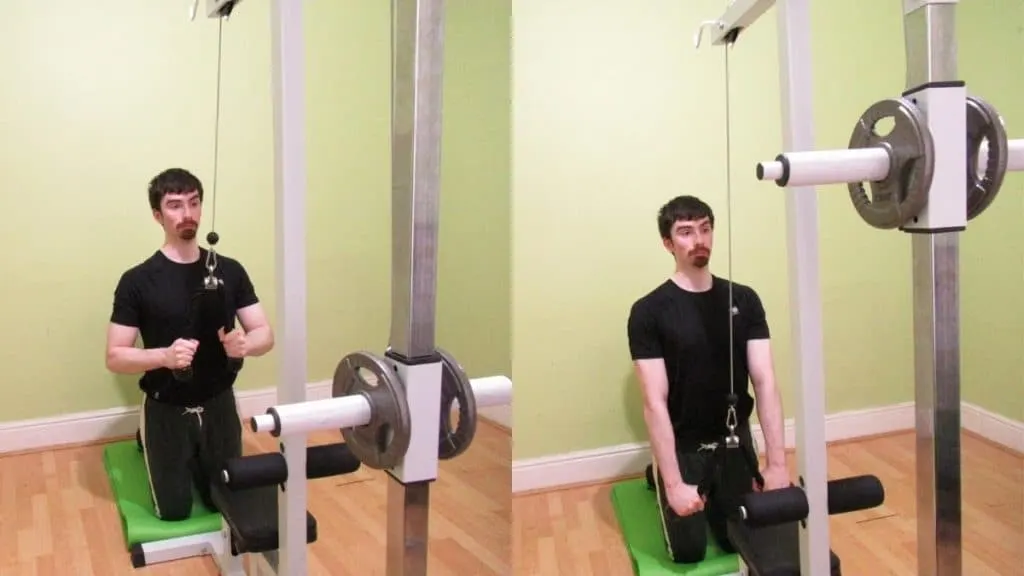
- Connect a rope attachment to a high pulley.
- Grab the rope and then assume a tall-kneeling position in front of the machine.
- Pull the rope down and tighten your core.
- Pin your elbows to your sides, and then flex your triceps to push the rope down toward the floor.
- Keep pushing until your elbows are completely locked out.
- Squeeze your triceps forcefully and hold the peak contraction for a moment.
- Slowly release the contraction while keeping your shoulders still and your elbows pinned to your sides.
- Raise the rope until it gets to around chest height, then perform your next rep.
- Do 3-5 sets of 10-20 reps in total.
Kneeling tricep pushdown variations
Here are 8 additional types of kneeling tricep pushdowns that you can do using a variety of attachments, grips, and body positions.
Kneeling v-bar pressdown
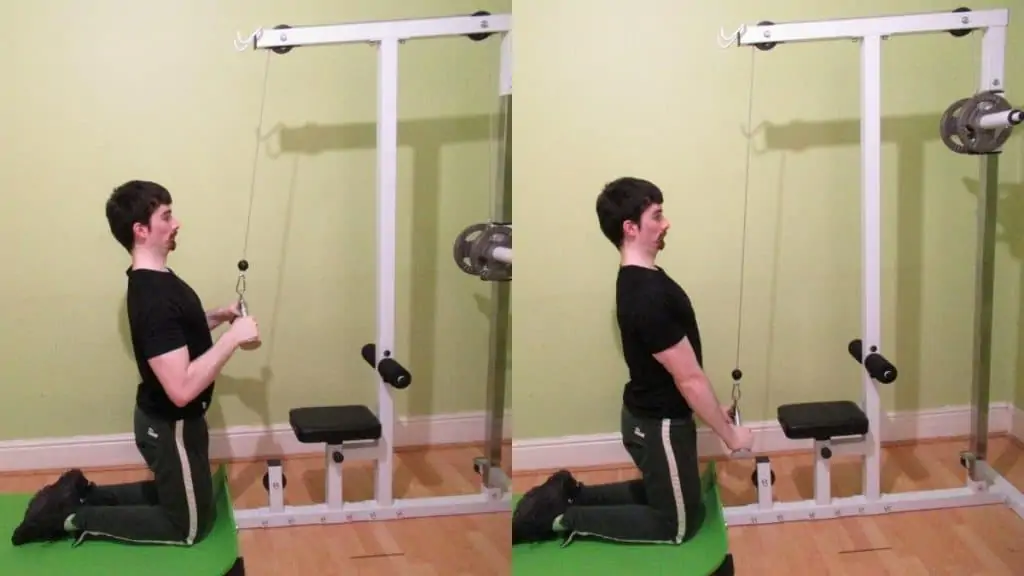
The kneeling v grip pressdown is exactly the same as the kneeling rope pushdown in terms of lifting technique: Extend your arms while keeping your elbows close to your sides.
The difference is that you can lift a bit heavier on the v bar version because v bars are easier to stabilize than rope attachments. Since the v bar is easier to balance, you’re able to generate more force and thus push heavier poundages.
The reason for rope attachments being harder to stabilize is that the sides of the rope are free-moving, whereas a v bar is a fixed attachment that doesn’t move from side to side.
Additionally, you have to lift and lock out each side of the rope independently, especially if you “split” or “twist” the ends of the rope in order to intensify contraction.
Straight bar kneeling tricep pushdowns

Kneeling straight bar triceps pushdowns enable you to lift plenty of weight so that you can overload your triceps and make them grow.
The trade-off for being able to use more plates on the cable stack is that straight bar attachments can often put a lot of pressure on your wrists because they force your hands into full pronation.
You also run the risk of developing tricep size asymmetries when you use a straight bar for any kind of pushdown. This is because when you lift the same attachment with both hands, there’s a high chance that your stronger triceps muscle will do more of the lifting and therefore receive better stimulation.
Besides trying to push into the bar with equal amounts of force from both hands, there’s not much else that you can do to avoid differential triceps stimulation when using a bilateral training tool like a bar.
Thankfully, there is a way to combat the wrist pain problem, and it’s coming up next.
EZ kneeling cable pushdown
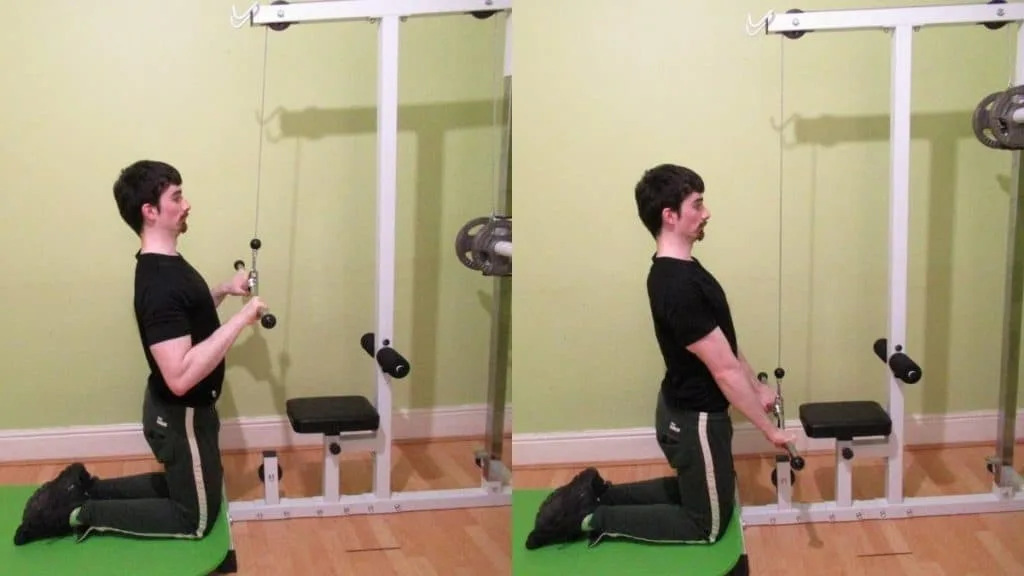
In terms of lifting technique, the kneeling EZ bar pressdown is identical to the straight bar kneeling pressdown.
The difference is in the design of the bars and how they affect your wrist comfort.
EZ bar attachments have curved or semi-pronated grips, which most lifters have no problem holding during kneeling pushdowns.
Straight bars, on the other hand, are completely flat and thus force your wrists into extreme amounts of pronation, a grip that often rears its ugly head as the weights become heavier.
In terms of joint-friendly grips, the kneeling band pushdown is another good option because you can hold each side of the band with a neutral grip, which is the grip that’s widely considered the safest to use during resistance training.
Half-kneeling tricep pushdown
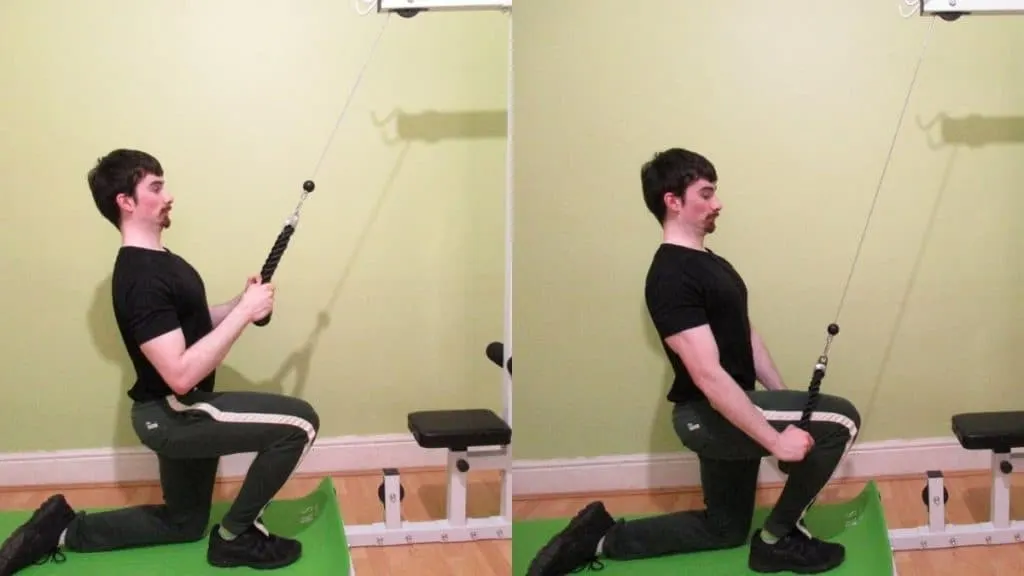
If you like the idea of doing your cable pressdowns kneeling down but don’t like having to contract your abs so hard, the half-kneeling tricep pushdown is an excellent compromise.
Since your front leg takes more of the strain during the half-kneeling pushdown, you’re unlikely to work your abs at the expense of your triceps.
With the tall-kneeling tricep pushdown, on the other hand, maintaining a strong, upright torso position is highly challenging (and sometimes close to impossible) if you’re really strong on pushdowns.
The reason that kneeling triceps pushdowns work your abs so much is that the force of the cables is always trying to pull your body toward the machine.
Half-kneeling tricep pushdowns, as noted, decrease the core stability requirement of the exercise, which in turn enables you to establish a better mind-muscle connection with your triceps.
Low-kneeling triceps pushdowns
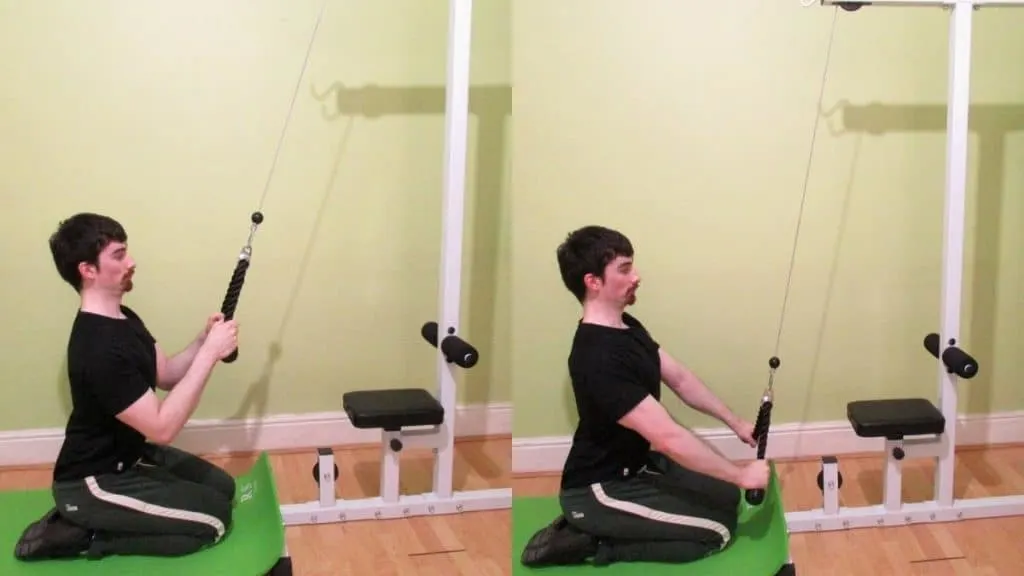
If you want to do everything in your power to take your abs out of the movement, then the low-kneeling pushdown is another good option.
Of course, if you really want to make the pushdown a triceps-first exercise, then you’re best off doing them in a standing position.
Nevertheless, assuming a low-kneeling position shifts more of your body weight onto your legs (your hips and thighs are literally resting on your calves), which means that your abs don’t have to contract as hard.
While the rope attachment is most recommended due to the fact that you can split the ends to intensify the peak contraction, you can also do the half-kneeling and low-kneeling tricep pressdowns with a straight bar, v bar, EZ bar, and single handle attachments.
You can also do a kneeling tricep pushdown using the assisted pull up station if you want to switch up your routine from cables to machines.
Kneeling reverse grip pressdown
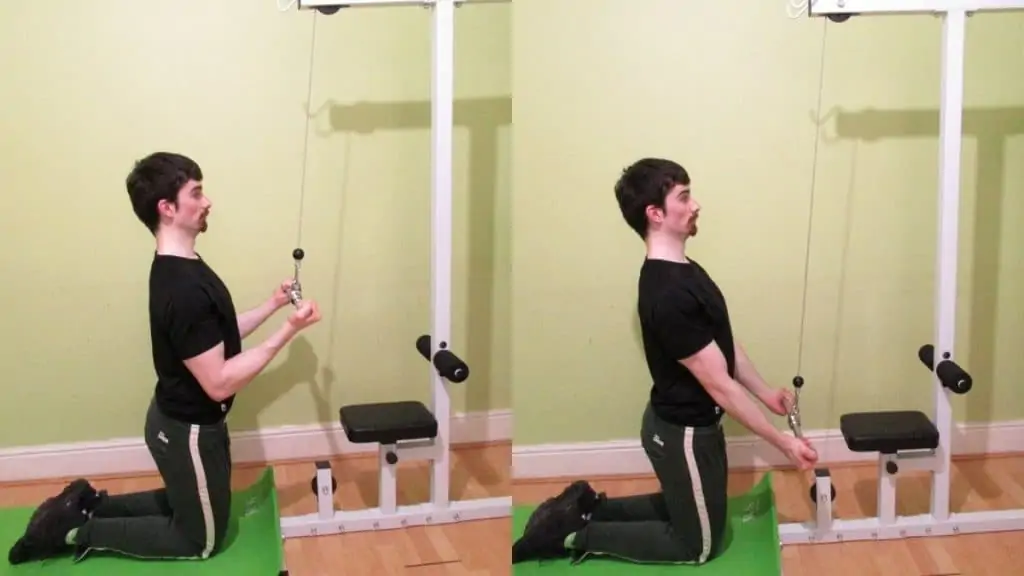
As with the other pushdown exercises, performing the cable underhand tricep extension in a kneeling position works your triceps and abs simultaneously.
However, because you’re using an underhand grip in this variation, your triceps naturally receive a better peak contraction. This is because performing pushdowns with a reverse grip encourages you to keep your elbows tucked in, which in turn enables your triceps to contract with more force.
The only downside of the reverse grip kneeling tricep pushdown is that the bar can sometimes hit your hips if you don’t grip it wide enough (with some bars, using a wide grip isn’t an option).
One arm kneeling triceps pushdown
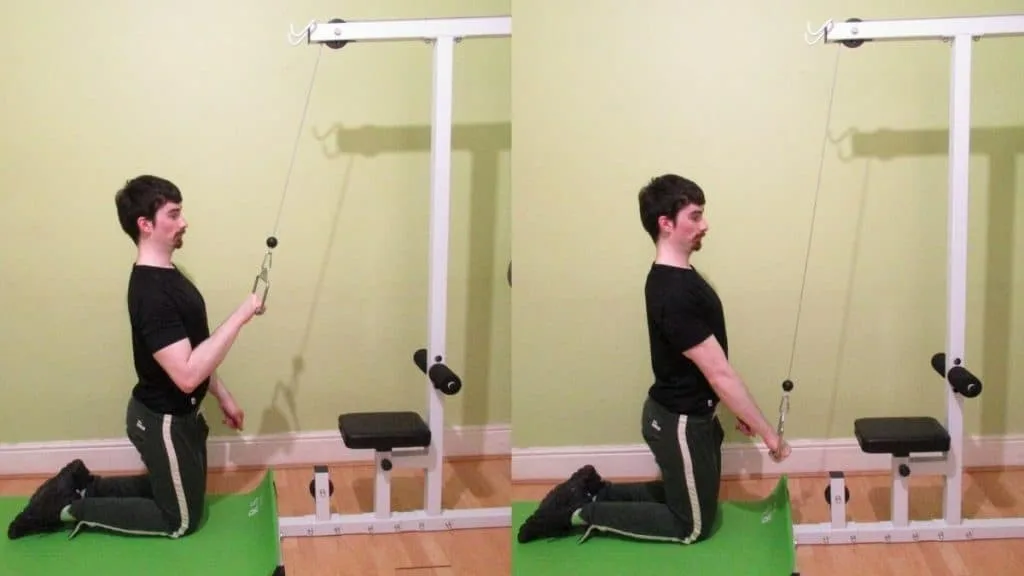
If your triceps already have a decent amount of mass but lack the symmetry to look truly aesthetic, then performing the kneeling one arm tricep pushdown makes a lot of sense.
By training unilaterally, which is to say by working each arm separately, you can make sure that both of your triceps are getting more or less equal amounts of work and thus growing roughly in proportion.
Another underappreciated benefit of one arm kneeling tricep pushdowns is that they help to make your triceps equally strong.
Having triceps of equal strength enables you to keep the bar straight during your bench press and shoulder press exercises, which, in addition to helping you lock the bar out more efficiently, further equalizes the amount of work that your triceps are getting.
You can also do the one arm reverse grip tricep extension in a kneeling position, which is ideal if the overhand version puts too much pressure on your wrists.
Isometric kneeling tri pushdown
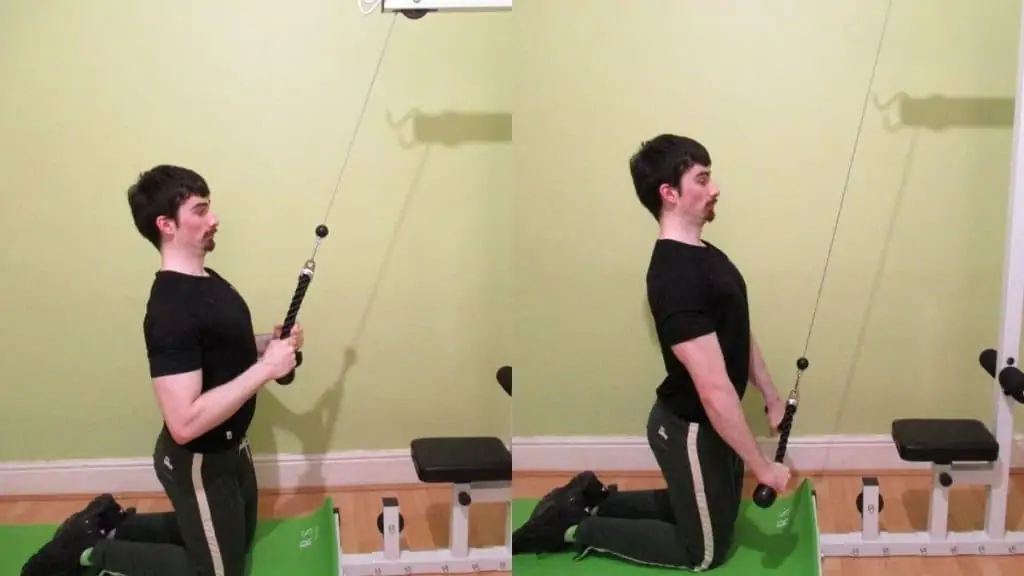
If you’ve been skipping the peak contraction part of tricep pushdowns, then performing a kneeling tricep pushdown with an iso hold can help to reinforce the importance of using a full range of motion.
There are two ways to go about iso pushdowns.
First off, you can perform prolonged contractions for 15-20 seconds, a technique that will also help to enhance your triceps endurance.
Second, you can perform sets of 6-12 reps whereby you hold the peak contraction on every rep for 3-5 seconds.
Try both variations and see which you prefer.
You can also use kneeling isometric pushdowns to warm up your elbows, in which case you’d want to stay away from muscular failure.
Conclusion: Which type of kneeling pushdown is best for building your triceps?
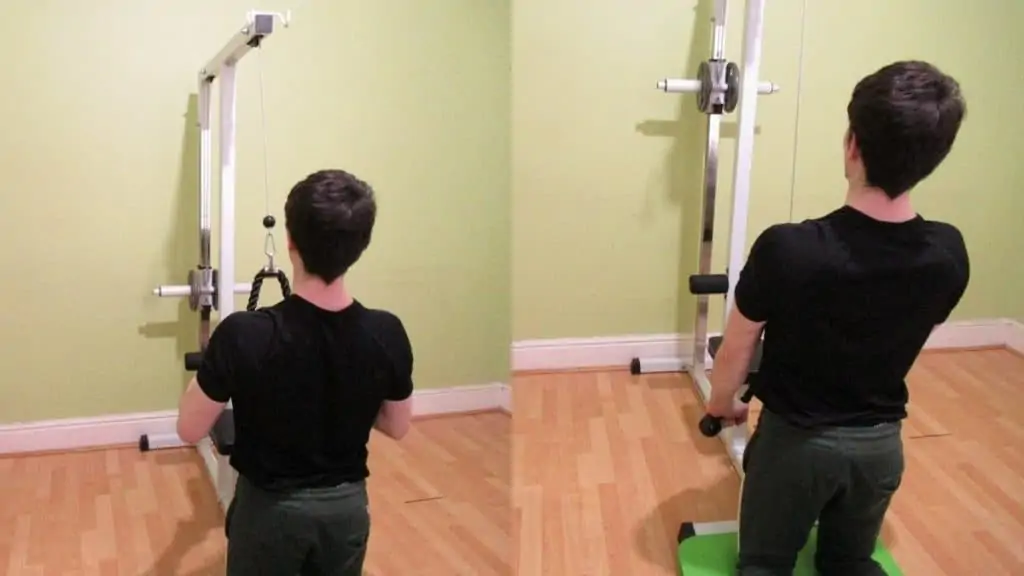
The best type of kneeling pushdown depends on your goals and equipment availability.
For example, if you want to improve your core strength and your triceps muscularity, then your best bet is to do a tall-kneeling tricep pushdown, as that’s the variation that requires the most abdominal exertion.
On the other hand, if you’re training for maximum triceps hypertrophy, then the half-kneeling triceps pushdown is a better choice because it has a lower core stability requirement, which makes it easier to focus on working your triceps.
The single arm kneeling pushdown is the most optimal variation for developing symmetrical triceps. But because you have to train each arm separately, it’s not ideal if you’re pressed for time because you’ll need to do double the number of sets.

